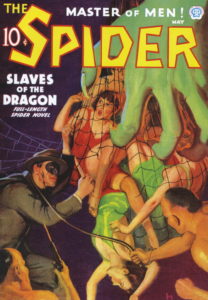
“Slaves of the Dragon” was originally published in the May 1936 issue of The Spider Magazine. White slavery, the loathsome traffic in women’s bodies, was stripping America of wives, sisters, and sweethearts. Richard Wentworth, valiant champion of human rights, knew that an Oriental master criminal was captaining the slavery syndicate, guessed the unspeakable purpose behind those wholesale abductions. But with Nita van Sloan hopelessly lost, with G-men harrying him relentlessly, can The Spider outwit his most formidable foeman and save America’s doomed womanhood?
Here’s another slam-bang “Yellow Peril” story of The Spider. It has all the things you’ve come to expect in a Spider story. Plenty of fast-paced action. And although written by Norvell Page, the story doesn’t have the quick, and annoying, wrap-up at the end. Yes, it ends quickly, but somehow it seems more complete and doesn’t seem almost arbitrary, as some of Norvell’s Spider stories do. There are still a few loose ends, but not many.
In the story are some hints of sex and rape, which is only to be expected in a story of white slavery, but there’s nothing too blatant. It’s more implied. It’s pretty obvious what the master villain means when he threatens Nita, “Surrender, or…” The helpless young damsel faces the proverbial fate worse than death.
The White Slavery trade
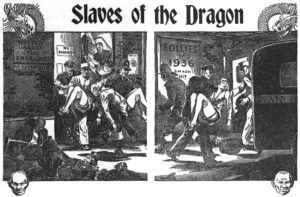
Richard Wentworth stumbles upon the white slavery trade as police raid a lingerie shop — one of the city’s most exclusive — on one of the most fashionable parts of Madison Avenue. He watches as a procession of women are hustled into a patrol wagon, their coats thrown over brief underclothing. But he quickly discerns that the police are fake; they are really mass kidnappers!
After a shootout that leaves several thugs dead, Wentworth takes after the escaping patrol wagon, actually a slavery van. He is joined by Margaret Stone, a woman whose sister was among those kidnapped. He’s not too happy to have her along, but she blackmails him. You see, she saw him affix The Spider seal to the forehead of one of the slain thugs, and threatens to tell police. Not a very smart thing to do, stamping the forehead of a dead man with his Spider seal while dressed as Wentworth, but now he’s stuck!
Wentworth follows the kidnappers to a warehouse where he learns that this is just part of a much bigger plot. Yes, the peril from the East… the Yellow Peril… has struck again. Chinese are kidnapping young white women to be sold into the harems of the East. Sold into slavery and… that fate worse than death. And every reader knew what that meant, back in those days.
Of course, he’s captured right off. And that’s the way he wants it. He wants to be taken to the big boss behind it all. He wants to identify the extent of the threat, and plan to exterminate it. It’s a young Chinese girl named Ya Hsai who leads him through a steel panel and through twisty passageways… and some pretty grisly death traps, to boot! I always love it when our hero has to maneuver through death traps to reach his goal. And this story has some doozies!
One of those death traps is referred to as the Devil’s Claw. We never actually get to see it, but we do get to see the carnage it produces. It swoops down out of the darkness from above, and behind it leaves the grisly, bloody bodies of all in its way. Of course, Ya Hsai leads a securely bound Wentworth safely past it.
A typical Spider frenzy
From there on, things start happening with a typical Spider frenzy. Let’s hit some of the highpoints. Wentworth nearly drowns in the black waters of the river flowing beneath the warehouse. He’s picked up by a police launch and Margaret Stone. Technically, he’s dead, but is resuscitated.
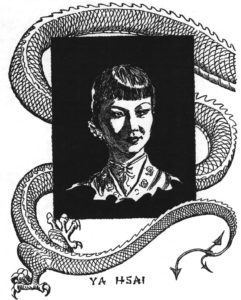
Jackson, the faithful chauffeur, is sent out to patrol the East River and keep an eye out for suspicious boats which may contain kidnapped women. Wentworth later tracks him down using a gadget worthy of Doc Savage. He flies over the river in his seaplane which is rigged with a photoelectric cell that receives infrared rays. It sounds a small buzzer when it receives a certain distinctive rhythm of them. The launch that Jackson pilots has a searchlight focused straight upward, emitting invisible infrared rays. By this means The Spider can find and follow Jackson far below. Pretty cool for a hero like The Spider who is more known for this disguises, but less so for his gadgets.
Wentworth tries to get the Feds involved, but it’s no-go. The story mentions “Hoover of the FBI,” which is unusual. Usually fictional characters are described when mention is made of real-life positions. The mayor of New York, the governor of New York, and even the president of the United States have all been mentioned in other Spider stories, and always they have been either unnamed or given fictional names. So it’s unusual that J. Edgar Hoover was specifically mentioned, here.
Apparently the G-men can’t get involved as long as the gang doesn’t cross state lines or use the mails. And to this point, they haven’t. But when a G-man is killed and the crimson stamp of The Spider is found on his forehead, they get involved… in a big way. The Feds are out to get The Spider! We know he’s been framed by the head of the white slavery ring, but the Feds don’t. So now The Spider has to elude them at the same time he tried to stop the white slavers.
The leader of the slavery racket is known as The Dragon. He’s an ancient Celestial who seems to be an inventor of sorts. He seems to come up with some pretty strange inventions involving sound… sounds that can paralyze a man… sounds that can dampen other sounds… stuff like that.
Wentworth first encounters this guy in Chinatown. He overhears a password spoken in Mandarin: The Dragon calls. When he uses that password and enters a confectionary shop, he is captured… yes, again… and led through underground passages filled with death traps… yes, again… and is taken by Ya Hsai… yes, again… to the leader, The Dragon. It may sound like this story is getting repetitive. But really, it’s not. Although the same things happen in general, the specifics are quite different and keep the story fresh and exciting.
When Wentworth is taken before The Dragon, he learns the extent of his vile plans. There will be a raid on a theater, 75 girls on stage, and 200 more in the audience. Also a raid on a college, 643 young college co-eds, all delivered by midnight. There’s also a thousand women in the women’s penitentiary who will be taken. Incensed by the enormity and the audacity of the foul plot, Wentworth leaps forward to kill The Dragon.
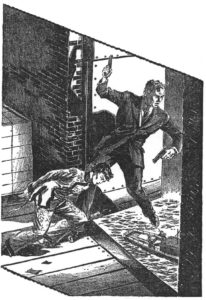
Ah, those inventions!
His attack is thwarted by an invention of sound which operates upon his muscles, rendering him weak and powerless. This is just one of The Dragon’s inventions mentioned in this story. We encounter another when the women’s prison is struck. The entire complement of guards and the Warden are murdered. Yet, no one in the surrounding community hears a thing. That’s because of another amazing sound-dampening invention of The Dragon. They are all pretty cool but unfortunately, they are used inconsistently and then never mentioned again. It’s as though they were created by the author on the spot to explain how The Dragon defeats his foes in a particular scene, and then abandoned. And they are never fully explained, just described fleetingly and then… we move on.
Wentworth has sent his true love Nita van Sloan to Washington, to see if she can pull some strings with her politician friends and get the FBI to become involved in the white slavery ring. His ulterior motive is to keep her out of harm’s way. But that fails, as she is kidnapped as soon as she arrives, and is taken by autogiro to a hidden base in the Great Dismal swamp on the Virginia-North Carolina border.
Meanwhile, all The Dragon’s plans have some to fruition. Thousands of women have been kidnapped. The women’s college has been stormed, the prison has been emptied and the theater has been attacked and all the woman taken away. And only The Spider stands in his way!
So what’s behind it all? It’s obvious that The Dragon won’t need that many women to fill the Harems of the East. Well, it turns out that a nation of Mongols, to remain unnamed, wants to “improve their race” by mating with white women. Don’t you just love the audacity of these plots? So The Dragon is just a hireling for this unspecified nation, and is plucking America’s innocent flowers to be taken somewhere in the East where huge, slow-witted Mongols will ravage their victims in order to produce smarter offspring. Something that outrageous just defies comment. I’m speechless.
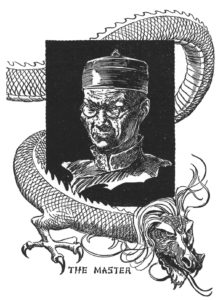
The prisoner women, of course, have no say in the matter. They dare not even kill themselves, for if they do, their bodies would be given to the soldiers (and you know what that means… a veiled reference to necrophilia… yeew!) and then afterwards the dogs would eat them.
This story is filled with sexual innuendo. It’s never overt, but hinted. Like when Nita is spread-eagled upon the ground, her ankles and wrists tied to four stakes; a line of coolie soldiers stand grinning down at her. A voice cries out to Wentworth: “Surrender and she shall have clean, swift death, otherwise…” The threat is not completed, but is implied.
And in a previous adventure
Reference is made to a previous adventure, when Wentworth had to convince police he was not The Spider. “Police suspicion had been directed toward him as The Spider before this, but had been laid to rest, he hoped, forever, when the commissioner, Kirkpatrick, had seen Wentworth and a person in the disguise of The Spider fighting side by side. Actually, it had been the woman to whom his heart was pledged, Nita van Sloan, valiantly risking her life to clear him.” Nita wore The Spider cloak more than once in this series. The first time was in the August 1935 story “Master of the Death-Madness,” which is probably the story referred to here.
In one very effective scene, Wentworth is tricked into firing his automatic, not knowing that Ram Singh is in the line of fire. He severely wounds his friend. While he tries to staunch the wound, they are attacked by thousands of starving rats. How will he escape this time? Author Norvell Page excelled at describing these extreme situations that seemingly had no escape, and then finding a way out for our hero. And he doesn’t let us down, here.
Some final points of interest
A few other points of interest in this story… Ram Singh is a Sikh in this tale, not a Hindu. In some of the early stories he was described as Hindu.
Wentworth has a secret method of communicating with Nita. In this story he telephones Nita and speaks with her, knowing their conversation is being overheard. He gives her a coded message, tapped with his fingernail upon the telephone mouthpiece. Nita knows to ignore his words and jot down his fingernail taps. In Morse code, they spell out the true message. Pretty clever, Spider!
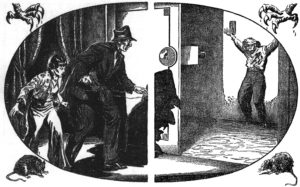
A passing comment gives us a little background on Wentworth: “He knew the East, none better. Many of his early years had been spent there.” And we’ve learned a bit more of Wentworth’s early history.
Wentworth has a camera obscura in his apartment. That’s an early version of today’s peephole, which uses a lens and mirror to project, in this case, an image of the outer hallway. But unlike a peephole, it actually projects the image on a screen. I liked that touch.
We are told that “The Spider had never shot a woman.” I’d have to check every single story, but somehow I doubt if that’s true. Maybe by this issue of the magazine it was true, but I doubt if that held for all 118 of the stories. I can’t verify that at the moment, but I suspect that sooner or later Wentworth would shoot a woman… if she was evil enough.
Again in this story we get to see Wentworth’s music room where he taps three pipes of the organ; a panel slides open, revealing The Spider’s dressing room. In some stories, that hidden room also includes a laboratory. In this tale, however, only the dressing room is mentioned.
Nita gets to fly an autogiro in this story. You probably knew she could fly an airplane, mentioned in other stories. And I suppose it’s not that far of a reach to assume she could also fly an autogiro. But now it’s stated for readers to know for sure!
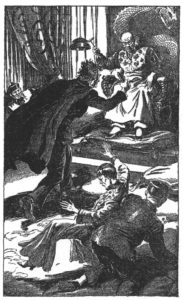
This story wraps things up quite nicely, with very few nagging questions or loose ends. Often when Norvell Page wrote his Spider stories, he seemed to do so quickly and wasn’t especially neat about cleaning up those details. This one, however, is pretty clean.
The one nagging detail for me was how the FBI knows a cigarette lighter is used to imprint The Spider seal. It’s just stated in passing. But I’m curious to know how they had determined the method of affixing that death mark on the victims’ foreheads.
And as for dangling plot threads, I only found one. Early in the story, Nita shows up with a young boy of 8 whose mother was one of the women kidnapped. She says, “I think I’ll adopt that little boy, Dick. He’s a nice little thing and so alone.” But we hear nothing more of Nita’s plan… and hear nothing more of the boy, either. Did his mother live, and he was returned to her? Was she one of the many casualties, and did Nita adopt him? Nothing further is known. Typical of Norvell Page.
Very few flaws in this story. And a lot going for it. Yes, there are racial stereotypes that are wildly offensive by today’s standards. This story is a product of its time, and you should keep that in mind as you read it. There’s action aplenty, thrills and chills, and a hint of some perverted sex… but never spelled out. It’s a fun way to spend some time with The Spider and it makes a story you’ll have trouble putting down.
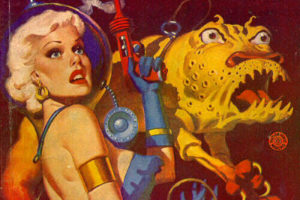

The camera obscura was an important device in two films: the 1946 Powell-Pressburger fantasy classic “A Matter of Life and Death” and the 1997 romantic comedy “Addicted To Love”. Basil Copper wrote a horror story about the device called (what else?) “Camera Obscura”, that became a memorable segment on Rod Serling’s “Night Gallery”.